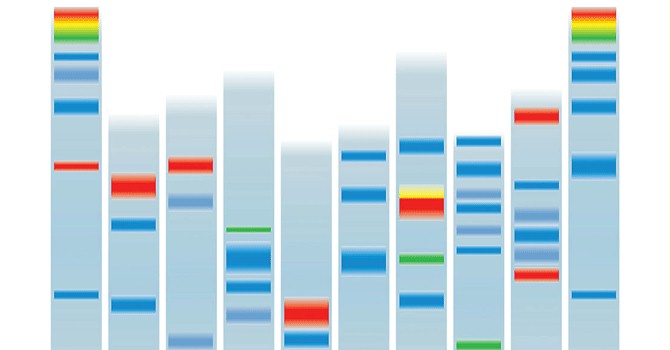
© 2015 50plus Senior News, All rights reserved.
The Search for Our Ancestry: DNA Decoded
Angelo Coniglio | Apr 9, 2013, 6 a.m.

Recently, genealogy has enjoyed a burst of interest, with more and more people from all nationalities, ethnicities, ages, and walks of life engaged in searches for their roots.
The availability of online information in such places as the free Mormon site FamilySearch (www.familysearch.org) and subscription sites like Ancestry.com has helped even amateur genealogists to find records about their families that were previously not readily available.
Along with the proliferation of sites for finding birth, marriage, and death records are the technological advances in the study of the human genome, the “blueprint” for our existence, and the accompanying analysis of DNA characteristics.
Every human has DNA markers that uniquely identify a person but are also shared to some extent by his or her relatives and ancestors. The more markers that are shared, the closer the relationship between two people. This characteristic of DNA lends itself to analysis of the “deep” genealogy of an individual.
There are numerous vendors of DNA tests who promise variously to determine ancestral origins and even to link to existing relatives, close or distant. I have been wanting to have my own DNA tested, partly to evaluate such claims and partly to see how the process works and what information I can find about my own heritage.
Recently, I finally decided to do it and submitted a saliva specimen to one of these vendors. My next two columns give some general information about DNA testing and where it may lead. When my DNA results come back, I’ll review them with you and evaluate their significance. Put your “biology thinking caps” on.
DNA is a nucleic acid that exists in the cells of all living things, animal or vegetable. Cells contain chromosomes, and the chromosomes contain DNA. The DNA, in turn, is made up of various sequential combinations and sequences of four basic chemicals called nucleotides. Within the DNA, the combinations of these chemicals form our genes.
Every cell in every human has 23 pairs of chromosomes. In your body’s cells, in 22 of these pairs, one chromosome came from your mother and one from your father. These 22 pairs are called autosomal chromosomes, or autosomes.
The 23rd chromosome pair is the one that determined your gender. If you’re a female, it has two X chromosomes, both passed down from your mother. If you’re a male, the 23rd chromosome pair has an X chromosome from your mother and a Y chromosome from your father. Accordingly, this 23rd pair is called the “sex chromosome pair.”
The distribution of DNA in your cells’ chromosomes is determined by the DNA of your parents, who in turn carried some of the DNA of each of
their parents, and so on. So, your autosomes essentially contain a complete genetic record, with all branches of your ancestry at some point contributing a piece of your autosomal DNA.
If you’re male, your XY chromosome pair also has this complete record, but if you’re female, your XX pair contains only the genetic history of your female line. In either case, your siblings and cousins share some of the same DNA markers with you.
The DNA from one’s parents is not passed on in exactly the same form, but is “recombined,” containing the same parts but usually in a different sequence. All of the parents’ DNA is not transferred, only random portions. Due to this, and to natural, random mutations, eventually the original DNA inherited from our ancient ancestors is so thinned out as to essentially be eliminated.
The various DNA testing programs utilize the DNA characteristics described above to determine likely ancestral roots from a sample of a person’s DNA. Save this column for reference, and next time I’ll discuss these programs’ similarities and differences.
|
Write to Angelo at genealogytips@aol.com or visit his
website, www.bit.ly/AFCGen.
He is the author of the book The Lady of the Wheel (La Ruotaia), based on his genealogical research of Sicilian foundlings. For more information, see www.bit.ly/SicilianStory. |





